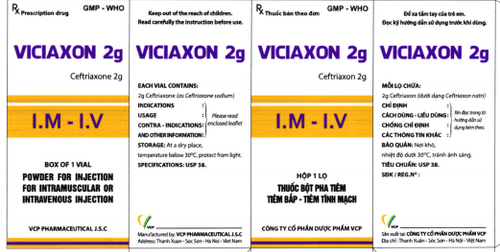This is an automatically translated article.
Aplastic anemia is anemia caused by dysfunction of the bone marrow. The disease can cause many complications such as infection, excess iron in the blood, heart failure, development of secondary breast cancer,... Severe aplastic anemia can lead to death.1. What is aplastic anemia?
Aplastic anemia is also known as bone marrow failure anemia. Bone marrow is the soft tissue in the bones that produces blood cells including red blood cells, white blood cells, and platelets. With aplastic anemia, the marrow cannot make more blood cells, causing anemia. Accordingly, the patient's test index was low in all 3 blood cell lines: red blood cells, neutrophils and platelets. The disease is common in young people aged 15-25 years.Aplastic anemia has 2 types, acquired and congenital. Among them, acquired aplastic anemia is more common, mainly with insidious onset due to extrinsic factors that trigger an autoimmune response. Congenital aplastic anemia mainly occurs in children, sometimes in middle-aged people (atypical manifestations of Fanconi syndrome occur in men about 30 years old and women about 48 years old). Aplastic anemia may develop gradually or occur suddenly. If the blood cell count is too low, it can be life-threatening.

Thiếu máu bất sản
2. Common symptoms in patients with aplastic anemia
Low white blood cell count: the patient has a fever, is prone to infectious diseases such as pneumonia, sinusitis and skin infections; Low platelet count: May cause bleeding from the vagina or nose, internal bleeding, and easy bruising of the skin; Low red blood cell count: Shortness of breath, feeling tired, lightheaded, headache, pale skin, poor health, irregular heartbeat; Easy bleeding, eg nosebleeds or bleeding gums; Easy bruising, hemorrhagic spots on the skin and mucous membranes; Retinal hemorrhage, menorrhagia; Gastrointestinal bleeding, blood in the stool or black stools; Tachycardia, feeling of palpitations, chest pain, shortness of breath, pale skin, not able to exercise much, weight loss; Common manifestations in patients with congenital aplastic anemia include: Short stature, small skull, nail dysplasia, abnormal thumb shape, pharyngeal leukoplakia, hyperpigmentation or hypopigmentation. Symptoms of aplastic anemia develop silently, lasting several months from the onset of the disease, from mild to more severe. Sometimes, symptoms suddenly worsen and the patient should be taken to the emergency room as soon as symptoms such as confusion, seizures, loss of consciousness, shortness of breath, loss of blood,...3. Causes of aplastic anemia
Hereditary aplastic anemia: Caused by a genetic defect, most common in children and young adults. If you have this form of the disease, you have a higher risk of developing leukemia or other types of cancer. Gene defects include: telomerase mutations (which make the patient susceptible to environmental influences), mutations in the TERC and TERT genes (genes that encode the RNA component of telomerase) and HLA-DRE presence. 2 times more than the average person; Acquired aplastic anemia: Non-regenerative anemia, autoimmune disease (immune system destroys healthy bone marrow cells), cancer destroys bone marrow cells, fibrosis of bone marrow cells, chemotherapy or radiation therapy for cancer, exposure to toxins or contaminants such as radiation or arsenic, Fanconi anemia, infections, leukemia, megaloblastic anemia, lupus erythematosus, folate or vitamin B12 deficiency, taking drugs that affect bone marrow function (including colchicine, chloramphenicol, therapeutics, thiazide diuretics, antiepileptics, azathioprine and non-steroidal anti-inflammatory drugs), viruses (Epstein-Barr). , HIV or viral hepatitis), pregnancy (rare).4. Diagnosis of aplastic anemia
Diagnosis is based on history, clinical examination; Blood test: Indicate the indicators of red blood cells, white blood cells and platelets in the blood; Liver function test, hepatitis, HIV,...; Bone marrow biopsy to identify potential causes of aplastic anemia. During the biopsy, marrow tissue is extracted by inserting a needle into the bone behind the pelvis. Then, the pulp tissue is examined under a microscope and other tests are done.5. Treatment of aplastic anemia
Early treatment will bring better results. There are two main treatment directions: immunosuppressive therapy and hematopoietic stem cell transplantation. The choice of treatment depends on the severity of the disease, the patient's age, and the likelihood of an HLA-matched donor among siblings.5.1 Drug use Immunosuppressive therapy: Combination of thymocyte-suppressing globulin with cyclosporine, treatment for patients over 40 years of age and who cannot find an HLA-matched donor. The patient survival rate is about 75%. For good responders, 90% of patients can live more than 5 years; Adjuvant therapy: Supportive blood transfusion (red blood cells, white blood cells or platelets); take antibiotics, antifungals and antivirals if necessary; oxygen therapy for patients with severe anemia; good oral hygiene, control of menorrhagia; avoid infectious agents, isolate sick people to cook necessary; HLA (human leukocyte antigen) testing for patients and family members. 5.2 Other surgery/procedure Hematopoietic stem cell transplantation for patients under 30 years of age with severe aplastic anemia and HLA-matched donors. The study was conducted in patients aged 30-40 years with good health conditions. Patients over 45 years of age have a higher rate of host-graft reaction and graft rejection compared with children. The survival rate is about 70-91% depending on the age of the patient receiving hematopoietic stem cell transplantation; Bone marrow transplantation from an unrelated donor when other therapies have failed and/or the patient is under 16 years of age, without an HLA-matched sibling; Remove the thymus if there is a tumor (thymoma). 5.3 Patient Monitoring Isolating if patient has severe neutropenia; Monitor your treatment closely as medications or other treatments can cause serious side effects; Diet for the patient: If leukopenia is present, foods containing less microorganisms should be used.

Cấy ghép tế bào gốc tạo máu
6. Complications of aplastic anemia
Patients with aplastic anemia are at risk of facing serious complications such as:Infections: Fungal, sepsis; Host-graft disease in bone marrow transplant patients (18% acute and 26% chronic); Side effects of immunosuppressive drugs; Too much iron in the blood (hemosiderosis) from a blood transfusion; Hemorrhage; Hepatitis caused by blood transfusion; Heart failure; Development of a secondary cancer such as malignant leukemia or myelodysplasia (risk of 15 - 19% for ages 6 - 10 years); Anemia of 3 lines resistant to treatment. In addition to the dangerous complications of the disease, the treatment of aplastic anemia with bone marrow transplantation has many other potential risks. Specifically, in a bone marrow transplant, doctors will use high doses of chemotherapy, inject the patient's donor bone marrow cells, and then administer steroid immunosuppressants such as prednisone to keep the immune system intact. non-rejection fluid.
Donor bone marrow cells can attack the patient's body, causing a serious complication called graft-versus-host disease. With this complication, the patient may develop rash, diarrhea, and hepatitis. Immunosuppressants can prevent this complication. In addition, the transplant can also lead to the risk of death from infection and the effects of chemotherapy. Other side effects of steroids can be low blood pressure and weight gain.
7. What is it like to live with aplastic anemia?
People with aplastic anemia should:
Avoid heavy sports to avoid injury and bleeding; Wash your hands often; Get a flu shot every year; Stay away from crowds to avoid spreading infectious diseases; Seek medical attention before flying or going to high places where there is little oxygen. It is possible that the patient must have a blood transfusion before leaving; Use medicine to treat the disease exactly as prescribed by the doctor; Periodic health check according to instructions; Adhere to a special diet if there is a low white blood cell count to limit bacterial exposure, avoid bacteria and pathogens from entering the body; Wear a medical bracelet to monitor your health continuously. Aplastic anemia can lead to severe infection and even death. Therefore, when there are warning symptoms of the disease, the patient should go to the doctor for an early diagnosis and timely treatment.
Please dial HOTLINE for more information or register for an appointment HERE. Download MyVinmec app to make appointments faster and to manage your bookings easily.













